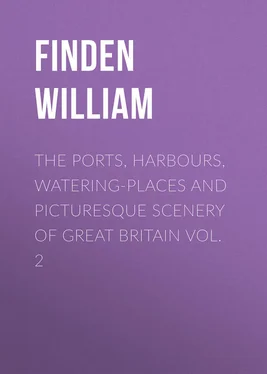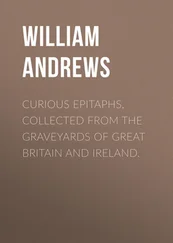William Finden - The Ports, Harbours, Watering-places and Picturesque Scenery of Great Britain Vol. 2
Здесь есть возможность читать онлайн «William Finden - The Ports, Harbours, Watering-places and Picturesque Scenery of Great Britain Vol. 2» — ознакомительный отрывок электронной книги совершенно бесплатно, а после прочтения отрывка купить полную версию. В некоторых случаях можно слушать аудио, скачать через торрент в формате fb2 и присутствует краткое содержание. Жанр: visual_arts, foreign_antique, foreign_prose, на английском языке. Описание произведения, (предисловие) а так же отзывы посетителей доступны на портале библиотеки ЛибКат.
- Название:The Ports, Harbours, Watering-places and Picturesque Scenery of Great Britain Vol. 2
- Автор:
- Жанр:
- Год:неизвестен
- ISBN:нет данных
- Рейтинг книги:3 / 5. Голосов: 1
-
Избранное:Добавить в избранное
- Отзывы:
-
Ваша оценка:
- 60
- 1
- 2
- 3
- 4
- 5
The Ports, Harbours, Watering-places and Picturesque Scenery of Great Britain Vol. 2: краткое содержание, описание и аннотация
Предлагаем к чтению аннотацию, описание, краткое содержание или предисловие (зависит от того, что написал сам автор книги «The Ports, Harbours, Watering-places and Picturesque Scenery of Great Britain Vol. 2»). Если вы не нашли необходимую информацию о книге — напишите в комментариях, мы постараемся отыскать её.
The Ports, Harbours, Watering-places and Picturesque Scenery of Great Britain Vol. 2 — читать онлайн ознакомительный отрывок
Ниже представлен текст книги, разбитый по страницам. Система сохранения места последней прочитанной страницы, позволяет с удобством читать онлайн бесплатно книгу «The Ports, Harbours, Watering-places and Picturesque Scenery of Great Britain Vol. 2», без необходимости каждый раз заново искать на чём Вы остановились. Поставьте закладку, и сможете в любой момент перейти на страницу, на которой закончили чтение.
Интервал:
Закладка:
Since the day it was first opened, the Menai Bridge has been the wonder of every traveller, an object of pilgrimage for scientific men of all countries, and a source of daily advantage to the United Kingdom, which no other work would have supplied. "The visiting of the Menai Bridge," says Mr. Smith, in his Guide to Snowdonia , "forms a new era in the lives of those who have not had that pleasure, and is a renewed luxury to those who have. There is something to be admired at every step: the effect of a passing carriage; the vibration caused by the mere application of the hand to the suspending-rods; the depth of a hundred feet to the level of the water; the fine view of the Straits in both directions; the lofty pillar erected in honour of Lord Anglesey; the diminutive appearance of persons on the shore; the excellence and strength of the workmanship, the beauty of the arches over the road through the suspension-piers, and the echo in them, all conspire to fascinate and detain the spectator. There is so much elegance, beauty, and magnificence, in this grand work of art, that it harmonizes and accords perfectly with the natural scenery around; and although in itself an object of admiration, still, in connexion with the features of the landscape, it heightens the effect of the general view."
"Seen, as I approached it," says Mr. Roscoe, "in the clear light of an autumnal sunset, which threw a splendour over the wide range of hills beyond, and the sweep of richly variegated groves and plantations which covered their base; the bright river, the rocky picturesque foreground; villas, spires, and towers here and there enlivening the prospect – the Menai Bridge appeared more like the work of some great magician than the mere result of man's skill and industry." Such were the encomiums lavished upon the first bridge which crossed the Menai; but men have since learned to view this structure with diminished admiration. Telford's great work no longer stands alone. The tubular bridge of his great successor, Stephenson, has taken its place beside the older and lighter work, and the very fact of its existence tends to diminish the wonder with which the first was looked upon.
PORT PENRHYN AND BANGOR
Bangor, although a city and the oldest see in the principality, is inconsiderable in size and population; but the natural beauty of its situation, the advantages which it commands from its inland as well as maritime connexion, and its excellent society, render the town and environs a most desirable place of residence, as well as a favourite resort for those families and individuals who employ the summer months in the pursuit of health, recreation, or improvement. The numerous walks, rides, and drives in the vicinity, all enhanced by their immediate and varied prospects of the sea, offer those facilities to health and enjoyment which cannot be too highly appreciated either by the tourist or resident. The city consists principally of one irregular street, fully a mile in length, with a fine vista towards the Menai – a name which the genius of Telford has rendered familiar to all the admirers of science and art. The houses are well-built, of a moderate size, neat in their appearance, and present to the stranger's eye a pleasing air of domestic comfort and progressive improvement. In the latter respect, no year passes away without contributing something to the public ornament or utility – objects which are zealously patronised by the influential inhabitants, and encouraged by those numerous and spirited visitors, estimated at fifty thousand annually, whom business or relaxation attract to the place. But to convey the best proof of the advances which Bangor has realised in the scale of provincial importance, and in all that has immediate reference to social and local improvements, we need only state that at the commencement of the present century the number of houses was only ninety-three, but that now it amounts to nine hundred or upwards. During three-quarters of the year a regular communication between Bangor and Liverpool is kept up by the steamboats that ply along this romantic and much-frequented coast, and which contribute greatly to the interests of the place. The environs are enlivened by many picturesque villas, and every accommodation is provided in the hotels and private lodging-houses for the reception of visitors.
The great object of general interest at Bangor is its cathedral, – a very ancient and venerable structure, – the foundation of which was among the earliest of those primitive temples which marked the triumphant progress of Christianity on the British soil. It is understood to have been founded by St. Daniel, at the commencement of the sixth century, and bears the sainted name of the founder. The choir was built by Bishop Deane, in or about 1496, and is used only for the cathedral service. The nave, built by Bishop Skivington in 1532, is fitted up as a parish church; and in one of the transepts the service is read in the Welsh tongue.
The free school, – founded in 1557 by Dr. Glynn, brother of the bishop of that name, – five daily schools within the parish, the central National school, four Sunday-schools, and almshouses, give a most favourable impression of the religious and civil advantages enjoyed by the inhabitants of Bangor, who evince a spirit and zeal worthy of those blessings which, in comparison with other and far more populous towns, place them in so enviable a position.
The principal export is the product of the slate-quarries, which is conveyed on a railway from Llandegai, six miles distant, to port Penrhyn, at the egress of the river Cegid into the Menai. This port is now capable of receiving vessels of large burden. It is nine hundred feet in length, and in all respects well adapted for the trading-craft which here take in their cargoes. The slates are of all dimensions, from large tombstone slabs down to the smallest size for roofing. For cyphering-slates, inkstands, and other fancy articles, there is a manufactory near the port. At a short distance is a handsome building containing hot and cold sea-water baths, with rooms for dressing and refreshment. The construction of this establishment, with its terrace and other appurtenances, is said to have cost the late Lord Penrhyn thirty thousand pounds. In the straits of Menai there is a good fishery, near Garth Ferry. There is a weekly market every Friday; and fairs are held in April, June, September, and October. No stranger should neglect to visit Penrhyn Castle, one of the finest baronial mansions in Europe.
BEAUMARIS, ANGLESEA
"I have stood gazing on Snowdon and Plinlimmon, the vale of Clwyd, the straits of Menai – lake, river, sea, and land – till they seemed of themselves to say, Stranger, well mayst thou gaze! we merit thine admiration – we are of God!"
Beaumaris is finely situated on the picturesque banks of the Menai, where it opens into the bay, and presents many attractions derived from its historical monuments, its natural advantages, and modern improvements. As the principal town in the island and county of Anglesea, it has long been a place of fashionable resort, and being at the same time the borough and market-town, it is a scene of considerable activity, cheerfulness, and animation. It is in general well built; particularly one street, the houses of which are large and commodious, and of superior design and execution. Of the original wall by which it was once enclosed, considerable portions still remain – sufficient to demonstrate, by their massive strength and durability, the iron features, and the no less iron policy of feudal times. The castle – erected by Edward the First, and now an imposing ruin close to the town – covers a large space of ground, but stands too low to produce that effect upon the spectator which it would have done had it, like so many of its cotemporaries, occupied an isolated and commanding position. It is surrounded by a deep fosse, with an entrance between two embattled walls on the east, with round and square towers. The gate opens into a spacious court, measuring fifty-seven yards by sixty, with four square towers, and an advanced-work on the east, called the Gunner's Walk. Within these was the keep – the body of the castle – nearly square, having a round tower at each angle, and another in the centre of each façade. The area forms an irregular octagon, of the dimensions above named. In the middle of the north side is the hall, twenty yards long by twelve broad, with two round towers, and several others about the inner and outer walls, built of a bluish stone intermixed with square stones, which produce a rather novel and pleasing effect.
Читать дальшеИнтервал:
Закладка:
Похожие книги на «The Ports, Harbours, Watering-places and Picturesque Scenery of Great Britain Vol. 2»
Представляем Вашему вниманию похожие книги на «The Ports, Harbours, Watering-places and Picturesque Scenery of Great Britain Vol. 2» списком для выбора. Мы отобрали схожую по названию и смыслу литературу в надежде предоставить читателям больше вариантов отыскать новые, интересные, ещё непрочитанные произведения.
Обсуждение, отзывы о книге «The Ports, Harbours, Watering-places and Picturesque Scenery of Great Britain Vol. 2» и просто собственные мнения читателей. Оставьте ваши комментарии, напишите, что Вы думаете о произведении, его смысле или главных героях. Укажите что конкретно понравилось, а что нет, и почему Вы так считаете.












